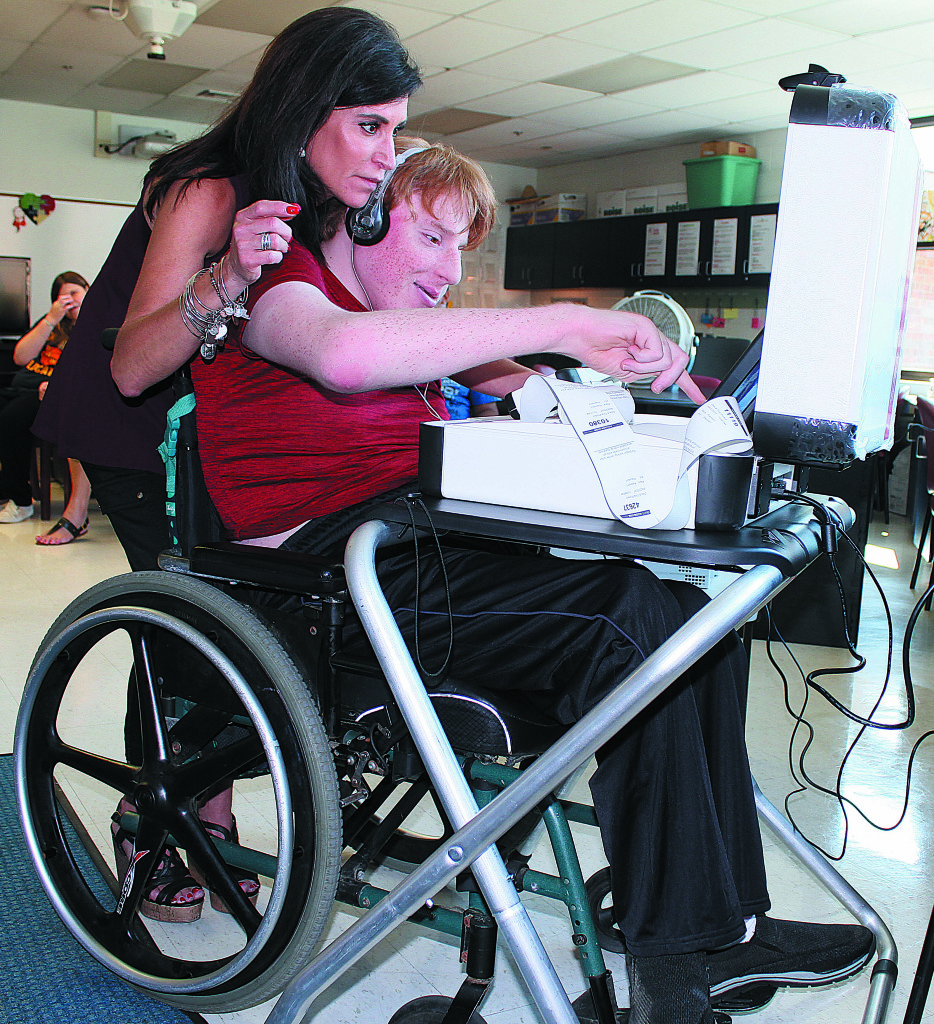
Folks with disabilities who are unable to vote using a traditional paper ballot or who find the voting experience to be difficult or stressful will be glad to know there’s new technology available at all the polls in Oakland County to make the democratic process easier and more accessible.
Made by Hart InterCivic, Inc., a company based in Austin, Texas, the Verity Touch Writer is a new, portable touchscreen ballot-marking device that includes an audio ballot reader and can accommodate various adaptive devices.
Oxford Township has five of the devices and they will be used for the first time in the Nov. 7 election. They cost $3,000 each and were paid for using federal funds, according to Clerk Curtis Wright.
This new technology was unveiled last week to a number of potential users in the LOFT classroom at Oxford High School.
LOFT stands for Learning Opportunities for Tomorrow. It’s an adult transition program for 18-to-26-year-old individuals with developmental disabilities or cognitive impairment. It teaches a variety of useful skills that enable students to lead productive, fulfilling and independent lives.
Township Deputy Clerk Susan McCullough and Kelly Richter, administrative assistant to the clerk, visited LOFT to demonstrate how the Verity Touch Writer works and give the folks there an opportunity to test it.
“I’m very excited about this new technology and I’m really happy that I got to try it out in my classroom with my students,” said LOFT founder and teacher Jeanne DiCicco. “I think that having this opens a whole new world for my population of students. This makes a difference for them.”
Using the Verity Touch Writer, voters mark digital ballots using either a 12-inch touchscreen interface or an Audio-Tactile Interface (ATI) named Verity Access that features a “move wheel” and select button. The wheel allows voters to navigate the ballot, then press the select button to make their choices.
Headphones can be plugged into Verity Access to allow voters with visual impairments or other issues to hear the ballot choices. Audio settings can be adjusted for volume, speed and pitch.
Adaptive controls, such as tactile switches and sip-and-puff devices, can be plugged into the Verity Access controller.
Sip-and-puff technology allows users to send signals to a device via air pressure created by inhaling (sipping) and exhaling (puffing) on a tube. This technology is mainly used by individuals who cannot use their hands.
When used, the Verity Access controller can either be docked with the Verity Touch Writer or held in hand. It’s attached to a tether, which allows it to be placed wherever it’s easiest for the voter to use.
The Verity Touch Writer also features a voting booth that offers easy wheelchair access.
The Verity Touch Writer is attached to a printer, which produces a paper copy of the ballot for placement in the Verity Scan, a digital scanner that records all the ballots (see story below).
McCullough believes the Verity Touch Writer is a vast improvement over the machine that was previously available to voters with disabilities. “It was cumbersome. I think I only ever saw two people use it,” she said. “Most of the time it didn’t work. It wouldn’t fire up. We’d have to call for service.”
“I think once people get used to (the Verity Touch Writer), they will use it a lot more,” McCullough added.
DiCicco believes this new technology will help lessen or eliminate the feelings of “anxiety” and “intimidation” that the idea of voting produces in them.
She explained that some of her students who are non-readers feel self-conscious if they have to have someone with them at the polls reading the ballot to them.
For others, the idea of putting pen to paper generates heightened anxiety because they lack the necessary fine motor skills, or dexterity.
These serve as deterrents for them when it comes to voting, according to DiCicco.
“If they feel uneasy about something, they just won’t do it like anyone else,” she said.
By having voting machines that are “way more user-friendly” and “more comfortable,” DiCicco believes more of her students will want to participate in the democratic process.
“Now, they can exercise their rights and feel good about it,” she said. “They’re going to be able to be independent, which is our goal.”
She believes these devices are ideally suited for them.
“They’re millennials, so they’re used to using computers and technology. It’s way easier for them than paper and pencil,” DiCicco said. “In our day and age, we use a ton of technology with the touchscreen, so they’re all familiar with it and they know how to use it. They all have iPads. They all have (cell) phones. So, this is perfect. This is definitely a step in the right direction for my population.”
DiCicco believes it’s very important for people like those in the LOFT program to vote because it’s another way for them to become involved in the place they call home.
“That’s what this program’s all about – giving them the independence to be able to live in the community and be part of the community,” she said.
DiCicco hopes people will remember that individuals with disabilities have “just as many rights as anybody else.”
“They’re citizens of the United States and they get to exercise that (right to vote) just like anyone else,” she said. “They should be treated just like everybody else. We want them to treat people with respect. They need to be treated with respect.”

Leave a Reply